Analyzing the Gender Wage Gap in the UK: Trends and Policies
VerifiedAdded on 2023/04/23
|14
|1900
|150
Report
AI Summary
This report investigates the gender wage gap in the UK, utilizing data analysis with Stata software to assess the average size of the gap and the impact of various policies implemented since 2007. The analysis includes a literature review of existing research on the topic, followed by an examination of real-world data to conduct regression analysis. The findings indicate a significant gender pay gap, although it has been gradually decreasing over time. The study also explores the influence of factors such as employment length and qualifications on the wage gap. Limitations of the research, including data accuracy issues, are acknowledged, and the report concludes with recommendations for companies and the government to further address gender wage inequality. Desklib provides access to this and similar solved assignments for students.

GENDER WAGE GAP 1
Gender Wage Gap
Name of Student
Institution
Course
Gender Wage Gap
Name of Student
Institution
Course
Paraphrase This Document
Need a fresh take? Get an instant paraphrase of this document with our AI Paraphraser
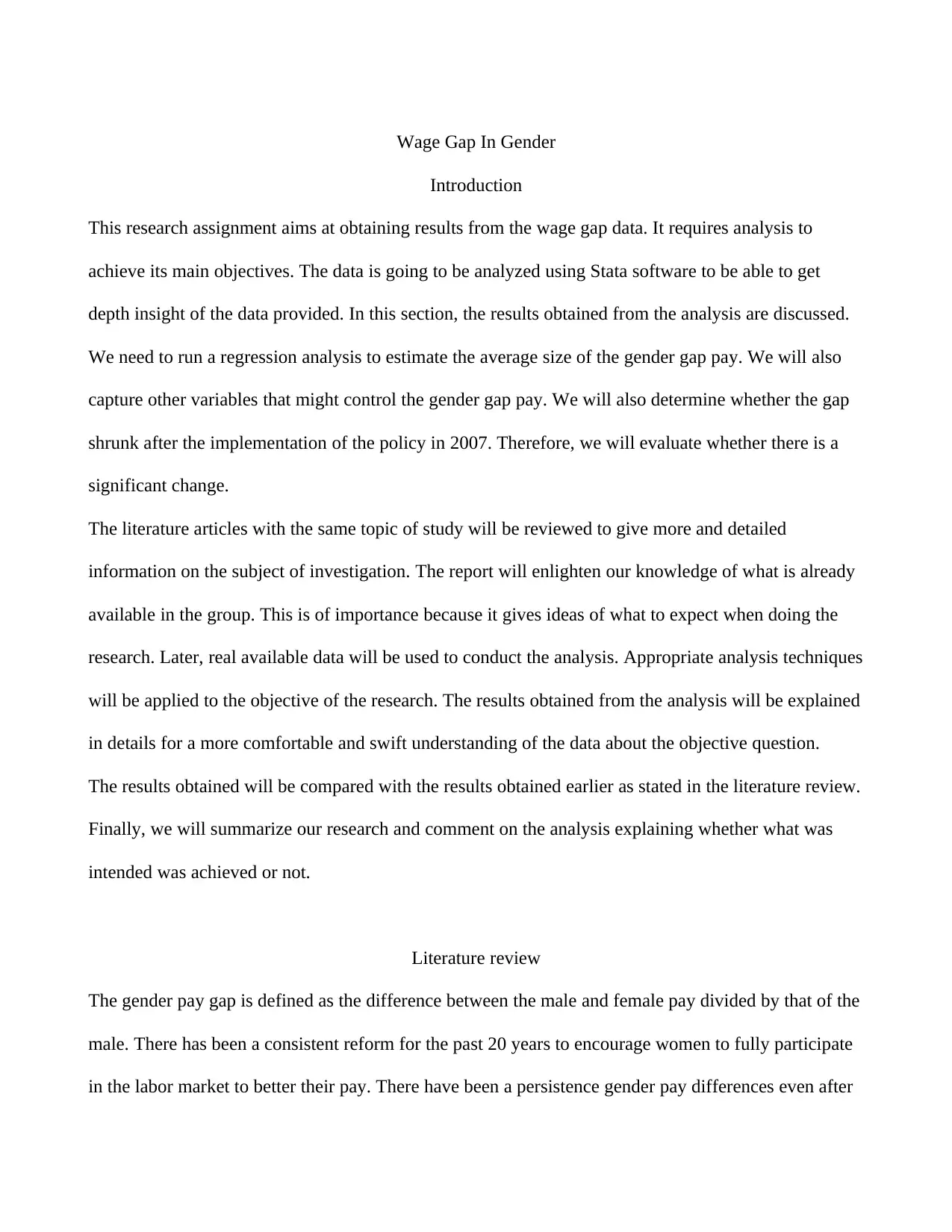
Wage Gap In Gender
Introduction
This research assignment aims at obtaining results from the wage gap data. It requires analysis to
achieve its main objectives. The data is going to be analyzed using Stata software to be able to get
depth insight of the data provided. In this section, the results obtained from the analysis are discussed.
We need to run a regression analysis to estimate the average size of the gender gap pay. We will also
capture other variables that might control the gender gap pay. We will also determine whether the gap
shrunk after the implementation of the policy in 2007. Therefore, we will evaluate whether there is a
significant change.
The literature articles with the same topic of study will be reviewed to give more and detailed
information on the subject of investigation. The report will enlighten our knowledge of what is already
available in the group. This is of importance because it gives ideas of what to expect when doing the
research. Later, real available data will be used to conduct the analysis. Appropriate analysis techniques
will be applied to the objective of the research. The results obtained from the analysis will be explained
in details for a more comfortable and swift understanding of the data about the objective question.
The results obtained will be compared with the results obtained earlier as stated in the literature review.
Finally, we will summarize our research and comment on the analysis explaining whether what was
intended was achieved or not.
Literature review
The gender pay gap is defined as the difference between the male and female pay divided by that of the
male. There has been a consistent reform for the past 20 years to encourage women to fully participate
in the labor market to better their pay. There have been a persistence gender pay differences even after
Introduction
This research assignment aims at obtaining results from the wage gap data. It requires analysis to
achieve its main objectives. The data is going to be analyzed using Stata software to be able to get
depth insight of the data provided. In this section, the results obtained from the analysis are discussed.
We need to run a regression analysis to estimate the average size of the gender gap pay. We will also
capture other variables that might control the gender gap pay. We will also determine whether the gap
shrunk after the implementation of the policy in 2007. Therefore, we will evaluate whether there is a
significant change.
The literature articles with the same topic of study will be reviewed to give more and detailed
information on the subject of investigation. The report will enlighten our knowledge of what is already
available in the group. This is of importance because it gives ideas of what to expect when doing the
research. Later, real available data will be used to conduct the analysis. Appropriate analysis techniques
will be applied to the objective of the research. The results obtained from the analysis will be explained
in details for a more comfortable and swift understanding of the data about the objective question.
The results obtained will be compared with the results obtained earlier as stated in the literature review.
Finally, we will summarize our research and comment on the analysis explaining whether what was
intended was achieved or not.
Literature review
The gender pay gap is defined as the difference between the male and female pay divided by that of the
male. There has been a consistent reform for the past 20 years to encourage women to fully participate
in the labor market to better their pay. There have been a persistence gender pay differences even after

the reforms. Comparing the UK to other countries, gender pay was better. The figure below summaries
the gender pay gap according to their respective countries.
There have been initiatives to reduce the gender pay gap over recent years. Employment and hours
were the factors that were being focused on. In 1997, the government of UK introduced labor policies
such that the low-income were targeted more so women.
The figure below shows the employment rate for both women and men from 1994 to 2014.
the gender pay gap according to their respective countries.
There have been initiatives to reduce the gender pay gap over recent years. Employment and hours
were the factors that were being focused on. In 1997, the government of UK introduced labor policies
such that the low-income were targeted more so women.
The figure below shows the employment rate for both women and men from 1994 to 2014.
⊘ This is a preview!⊘
Do you want full access?
Subscribe today to unlock all pages.

Trusted by 1+ million students worldwide

The figure below shows an increase in women income form 61 % to 69 % from 1994 to 2014. Even
though there was an increase in women's wages, the gap between females and males was persistent.
Another initiative was introduced in 2003 by the name ‘right to request flexible working' law' gave
parents who had children of ages below six more flexible working requirement which they were
allowed to request. Also, working rights were strengthened when part-time employment was introduced
in 2000. All these were submitted to favor the female. The impact of all these was still minimal.
The figure below shows the distribution of weekly work time for both the females and the males.
though there was an increase in women's wages, the gap between females and males was persistent.
Another initiative was introduced in 2003 by the name ‘right to request flexible working' law' gave
parents who had children of ages below six more flexible working requirement which they were
allowed to request. Also, working rights were strengthened when part-time employment was introduced
in 2000. All these were submitted to favor the female. The impact of all these was still minimal.
The figure below shows the distribution of weekly work time for both the females and the males.
Paraphrase This Document
Need a fresh take? Get an instant paraphrase of this document with our AI Paraphraser

It can be observed that most men worked for 40 hours a week while that of women were sparse. This is
because of the part-time employment issued to the female. In contrary, most men worked full time.
The minimum wage policy introduced in 1999 aimed at reducing the pay gap. It aimed at benefiting
those who had lower pay which was women. The hourly wage rate gap has been decreasing for the past
years. The graph below shows the hourly wage rate from 1994 to 2014.
because of the part-time employment issued to the female. In contrary, most men worked full time.
The minimum wage policy introduced in 1999 aimed at reducing the pay gap. It aimed at benefiting
those who had lower pay which was women. The hourly wage rate gap has been decreasing for the past
years. The graph below shows the hourly wage rate from 1994 to 2014.
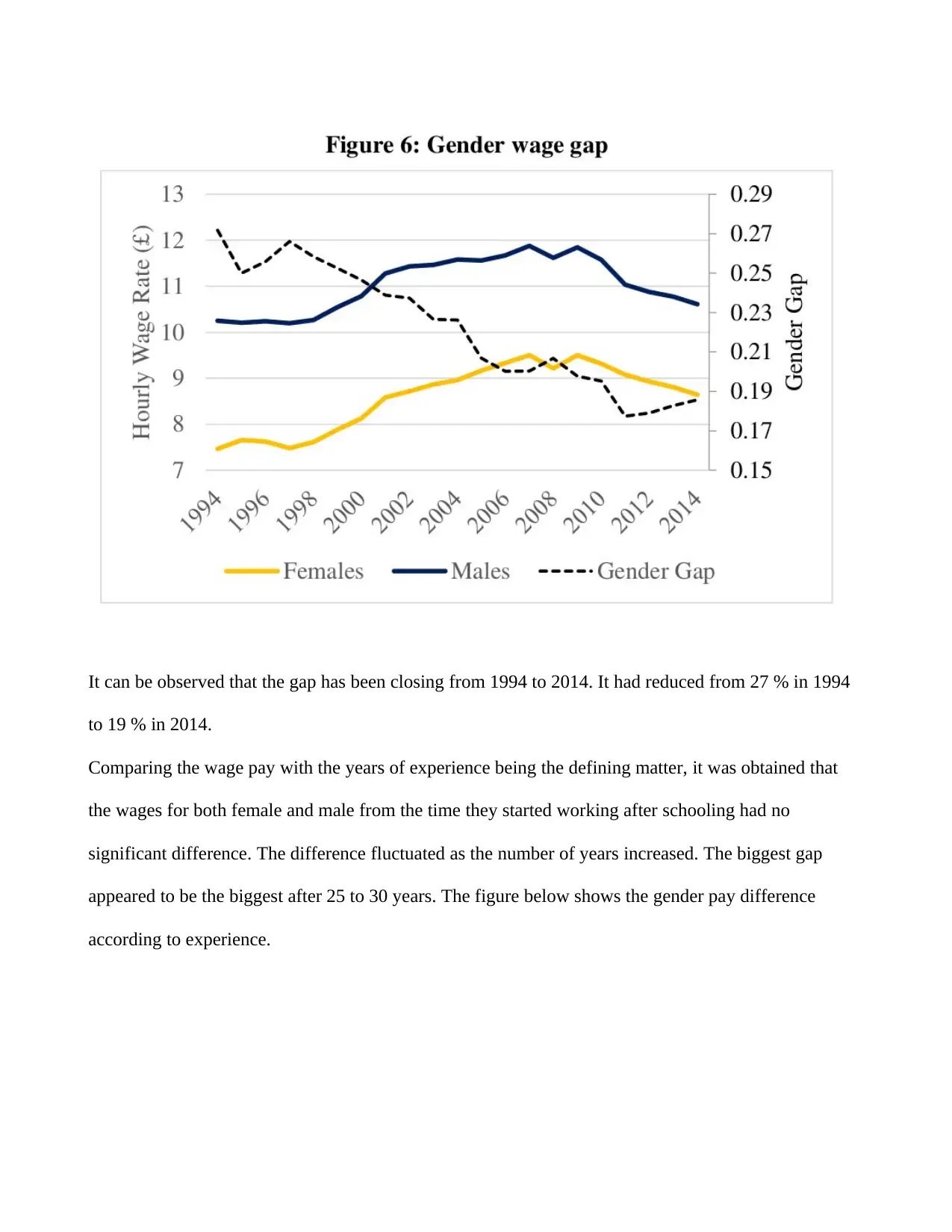
It can be observed that the gap has been closing from 1994 to 2014. It had reduced from 27 % in 1994
to 19 % in 2014.
Comparing the wage pay with the years of experience being the defining matter, it was obtained that
the wages for both female and male from the time they started working after schooling had no
significant difference. The difference fluctuated as the number of years increased. The biggest gap
appeared to be the biggest after 25 to 30 years. The figure below shows the gender pay difference
according to experience.
to 19 % in 2014.
Comparing the wage pay with the years of experience being the defining matter, it was obtained that
the wages for both female and male from the time they started working after schooling had no
significant difference. The difference fluctuated as the number of years increased. The biggest gap
appeared to be the biggest after 25 to 30 years. The figure below shows the gender pay difference
according to experience.
⊘ This is a preview!⊘
Do you want full access?
Subscribe today to unlock all pages.

Trusted by 1+ million students worldwide

Paternity leave legislation was also introduced to help reduce the pay gap. The fathers were allowed a
paid two weeks paternity leave to about 26 weeks as proposed in 2011. The parents shared the leave to
help them take care of their children. In March 2015, Liberal Democrats demanded transparency in the
pay gap. The legislation would fine a company for failing to disclose the pay for both the females and
the males a fine of up to £5,000. The main factor that explained the reason for the gender pay gap was
the occupation. Only 35 % of female were involved in the highest paying occupations such as
managerial and directory. 80 % of the women were engaged in low paying occupation such as tearing
and leisure services. The figure below shows the relationship of the average pay according to the type
of profession1.
1 Azmat, G., 2015. Gender Gaps in the UK Labour Market: jobs, pay and family-friendly
policies. London School of Economics and Political Science: Centre for Economic Performance.
paid two weeks paternity leave to about 26 weeks as proposed in 2011. The parents shared the leave to
help them take care of their children. In March 2015, Liberal Democrats demanded transparency in the
pay gap. The legislation would fine a company for failing to disclose the pay for both the females and
the males a fine of up to £5,000. The main factor that explained the reason for the gender pay gap was
the occupation. Only 35 % of female were involved in the highest paying occupations such as
managerial and directory. 80 % of the women were engaged in low paying occupation such as tearing
and leisure services. The figure below shows the relationship of the average pay according to the type
of profession1.
1 Azmat, G., 2015. Gender Gaps in the UK Labour Market: jobs, pay and family-friendly
policies. London School of Economics and Political Science: Centre for Economic Performance.
Paraphrase This Document
Need a fresh take? Get an instant paraphrase of this document with our AI Paraphraser
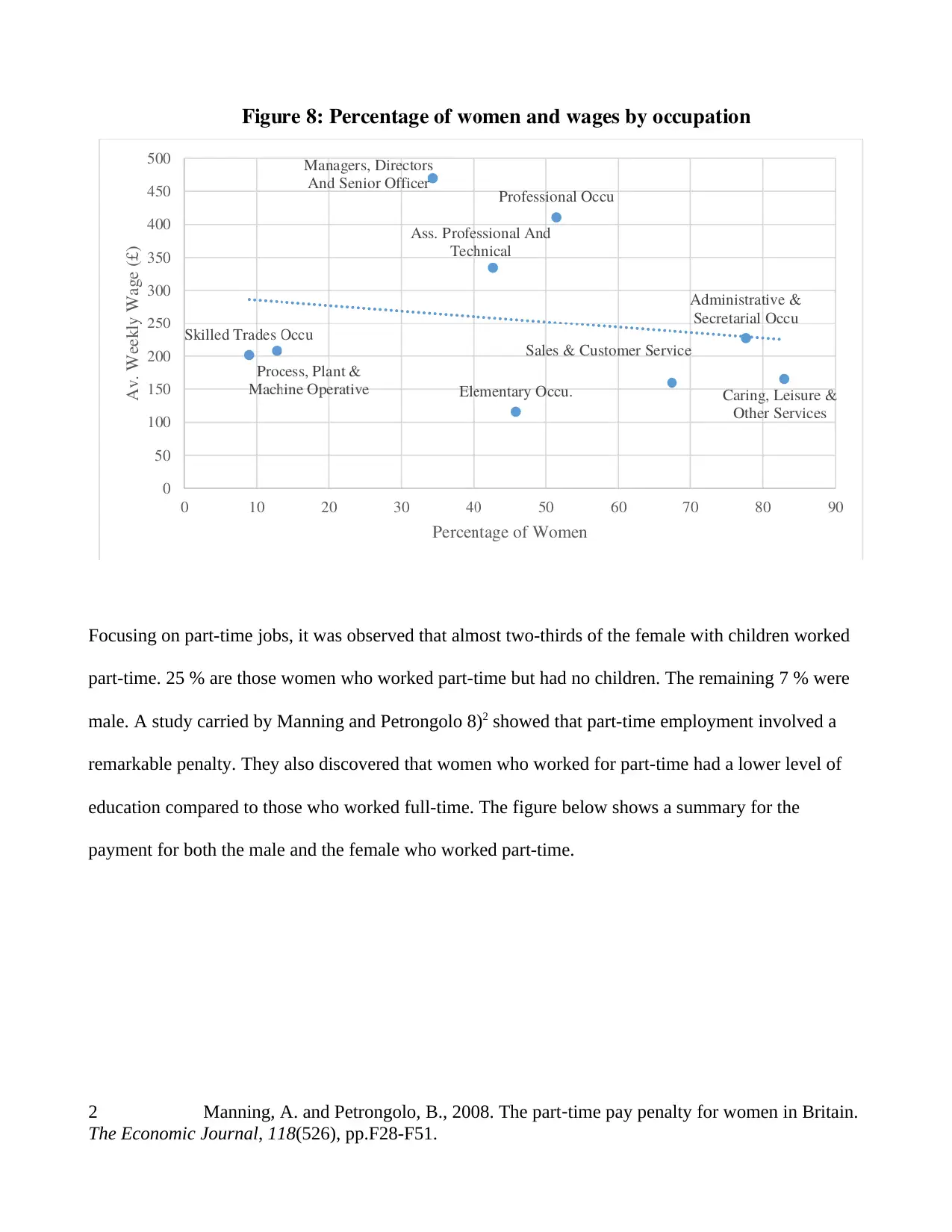
Focusing on part-time jobs, it was observed that almost two-thirds of the female with children worked
part-time. 25 % are those women who worked part-time but had no children. The remaining 7 % were
male. A study carried by Manning and Petrongolo 8)2 showed that part-time employment involved a
remarkable penalty. They also discovered that women who worked for part-time had a lower level of
education compared to those who worked full-time. The figure below shows a summary for the
payment for both the male and the female who worked part-time.
2 Manning, A. and Petrongolo, B., 2008. The part‐time pay penalty for women in Britain.
The Economic Journal, 118(526), pp.F28-F51.
part-time. 25 % are those women who worked part-time but had no children. The remaining 7 % were
male. A study carried by Manning and Petrongolo 8)2 showed that part-time employment involved a
remarkable penalty. They also discovered that women who worked for part-time had a lower level of
education compared to those who worked full-time. The figure below shows a summary for the
payment for both the male and the female who worked part-time.
2 Manning, A. and Petrongolo, B., 2008. The part‐time pay penalty for women in Britain.
The Economic Journal, 118(526), pp.F28-F51.
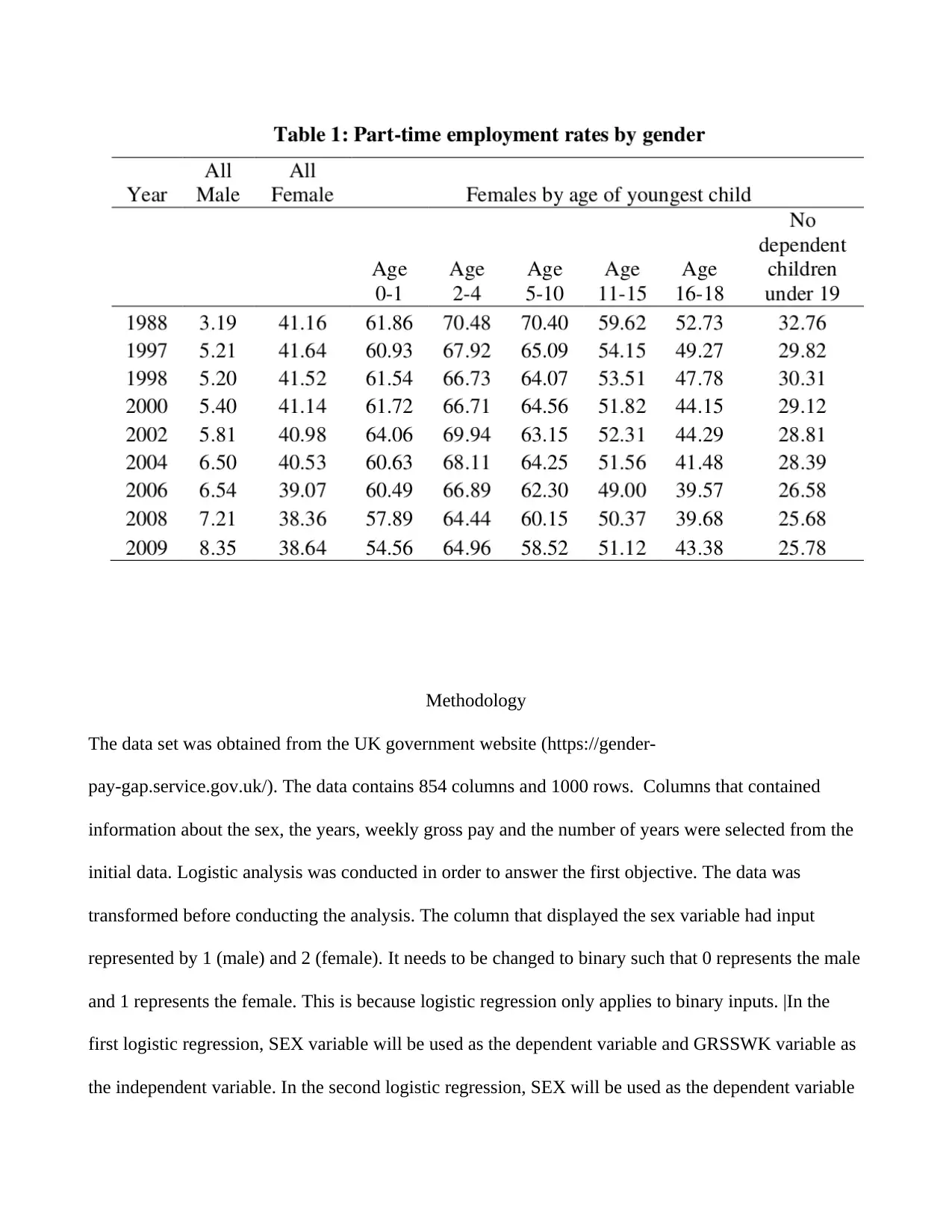
Methodology
The data set was obtained from the UK government website (https://gender-
pay-gap.service.gov.uk/). The data contains 854 columns and 1000 rows. Columns that contained
information about the sex, the years, weekly gross pay and the number of years were selected from the
initial data. Logistic analysis was conducted in order to answer the first objective. The data was
transformed before conducting the analysis. The column that displayed the sex variable had input
represented by 1 (male) and 2 (female). It needs to be changed to binary such that 0 represents the male
and 1 represents the female. This is because logistic regression only applies to binary inputs. |In the
first logistic regression, SEX variable will be used as the dependent variable and GRSSWK variable as
the independent variable. In the second logistic regression, SEX will be used as the dependent variable
The data set was obtained from the UK government website (https://gender-
pay-gap.service.gov.uk/). The data contains 854 columns and 1000 rows. Columns that contained
information about the sex, the years, weekly gross pay and the number of years were selected from the
initial data. Logistic analysis was conducted in order to answer the first objective. The data was
transformed before conducting the analysis. The column that displayed the sex variable had input
represented by 1 (male) and 2 (female). It needs to be changed to binary such that 0 represents the male
and 1 represents the female. This is because logistic regression only applies to binary inputs. |In the
first logistic regression, SEX variable will be used as the dependent variable and GRSSWK variable as
the independent variable. In the second logistic regression, SEX will be used as the dependent variable
⊘ This is a preview!⊘
Do you want full access?
Subscribe today to unlock all pages.

Trusted by 1+ million students worldwide
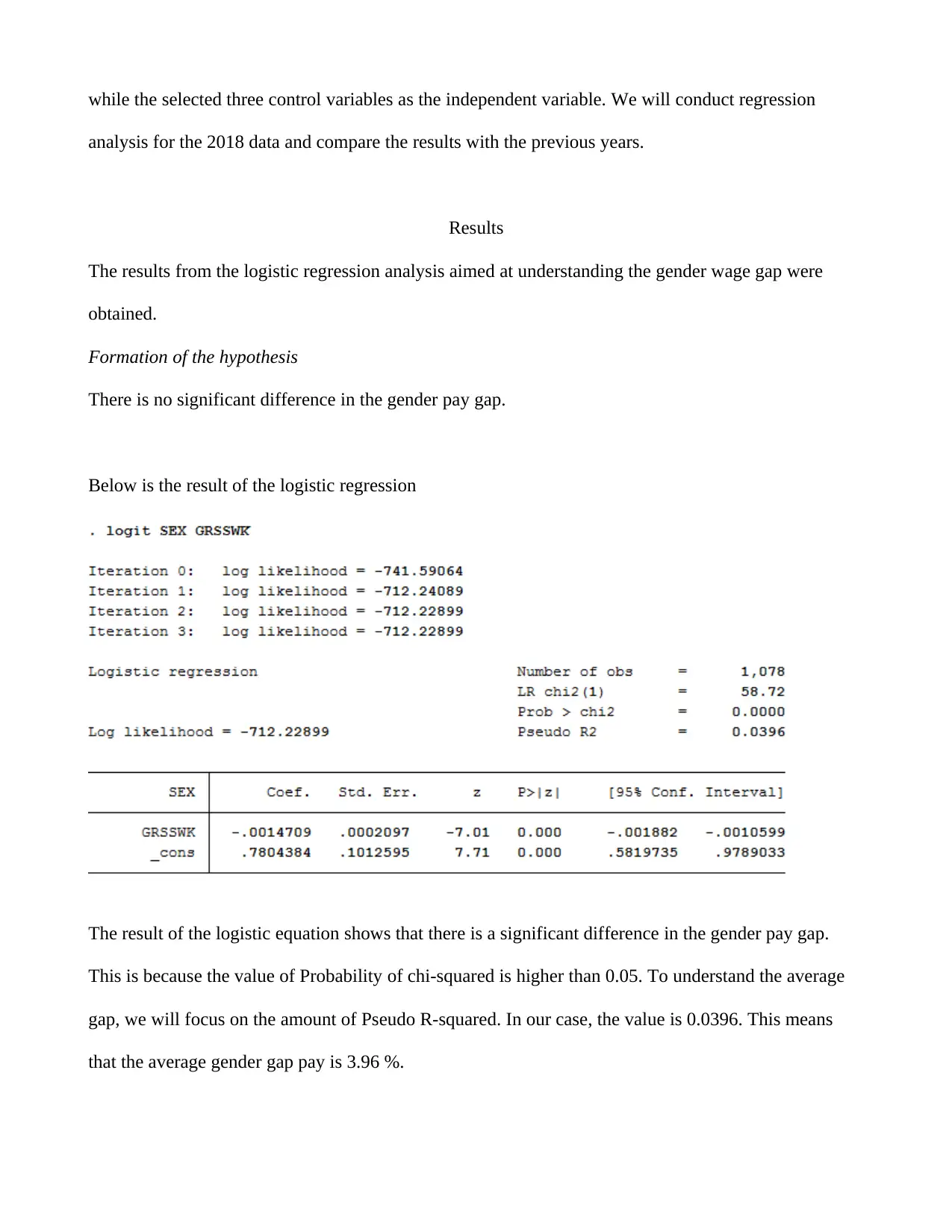
while the selected three control variables as the independent variable. We will conduct regression
analysis for the 2018 data and compare the results with the previous years.
Results
The results from the logistic regression analysis aimed at understanding the gender wage gap were
obtained.
Formation of the hypothesis
There is no significant difference in the gender pay gap.
Below is the result of the logistic regression
The result of the logistic equation shows that there is a significant difference in the gender pay gap.
This is because the value of Probability of chi-squared is higher than 0.05. To understand the average
gap, we will focus on the amount of Pseudo R-squared. In our case, the value is 0.0396. This means
that the average gender gap pay is 3.96 %.
analysis for the 2018 data and compare the results with the previous years.
Results
The results from the logistic regression analysis aimed at understanding the gender wage gap were
obtained.
Formation of the hypothesis
There is no significant difference in the gender pay gap.
Below is the result of the logistic regression
The result of the logistic equation shows that there is a significant difference in the gender pay gap.
This is because the value of Probability of chi-squared is higher than 0.05. To understand the average
gap, we will focus on the amount of Pseudo R-squared. In our case, the value is 0.0396. This means
that the average gender gap pay is 3.96 %.
Paraphrase This Document
Need a fresh take? Get an instant paraphrase of this document with our AI Paraphraser

We selected the variables EMPLEN and FORTYP15 as our control variables to understand the gender
gap. The two variables signified the length of time of current employment and types of qualifications.
Formulation of hypothesis
The length of time of current employment and the type of qualifications has no significant effect on the
gender pay gap
Below is the output of the results
The results obtained from the analysis rejects the hypothesis since the value of probability chi-square
less than 0.05. Therefore we can deduce that the time of the current employment (experience) and the
type of qualifications. To determine the level of significance from the variables, we will focus on the
value of Pseudo R-squared. Only 4.17 % of the dependent variables affected the gender gap pay.
The regression analysis for the same variables for the year 2018 is as below.
gap. The two variables signified the length of time of current employment and types of qualifications.
Formulation of hypothesis
The length of time of current employment and the type of qualifications has no significant effect on the
gender pay gap
Below is the output of the results
The results obtained from the analysis rejects the hypothesis since the value of probability chi-square
less than 0.05. Therefore we can deduce that the time of the current employment (experience) and the
type of qualifications. To determine the level of significance from the variables, we will focus on the
value of Pseudo R-squared. Only 4.17 % of the dependent variables affected the gender gap pay.
The regression analysis for the same variables for the year 2018 is as below.

We can deduce from the table that there was a no significant change in the gender gap between 2017
and 2018.
Discussion
From the analysis, we managed to show that there was a significant gap between gender wages. The
difference has been reducing each year. This is according to the research conducted by Azmat in 2015
using the previous wage gap data. The study obtained may not have been accurate because the level of
error was too high. Some of the participants didn't provide the required data for specific questions.
Some of them were not answering the questions appropriately. This is the main limitation of our
research. The results obtained from the research has a great apparition on the gender wage up. Even
though companies have been trying to succumb to this issue, they still need to do much to reduce the
gender wage gap. The government should also follow up to make sure that there is insignificant gender
wage gap in the companies. The study is open for future research since the information obtained has
some errors.
Conclusion
and 2018.
Discussion
From the analysis, we managed to show that there was a significant gap between gender wages. The
difference has been reducing each year. This is according to the research conducted by Azmat in 2015
using the previous wage gap data. The study obtained may not have been accurate because the level of
error was too high. Some of the participants didn't provide the required data for specific questions.
Some of them were not answering the questions appropriately. This is the main limitation of our
research. The results obtained from the research has a great apparition on the gender wage up. Even
though companies have been trying to succumb to this issue, they still need to do much to reduce the
gender wage gap. The government should also follow up to make sure that there is insignificant gender
wage gap in the companies. The study is open for future research since the information obtained has
some errors.
Conclusion
⊘ This is a preview!⊘
Do you want full access?
Subscribe today to unlock all pages.

Trusted by 1+ million students worldwide
1 out of 14
Related Documents
Your All-in-One AI-Powered Toolkit for Academic Success.
+13062052269
info@desklib.com
Available 24*7 on WhatsApp / Email
![[object Object]](/_next/static/media/star-bottom.7253800d.svg)
Unlock your academic potential
Copyright © 2020–2025 A2Z Services. All Rights Reserved. Developed and managed by ZUCOL.





